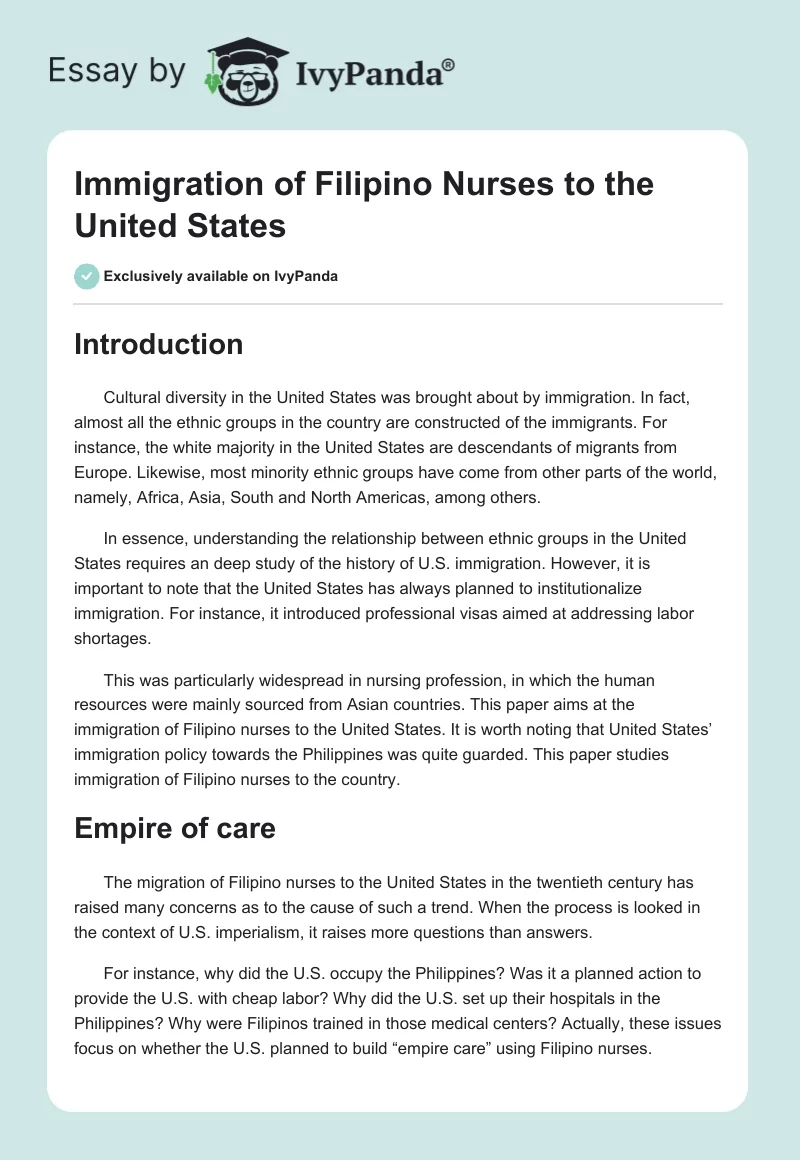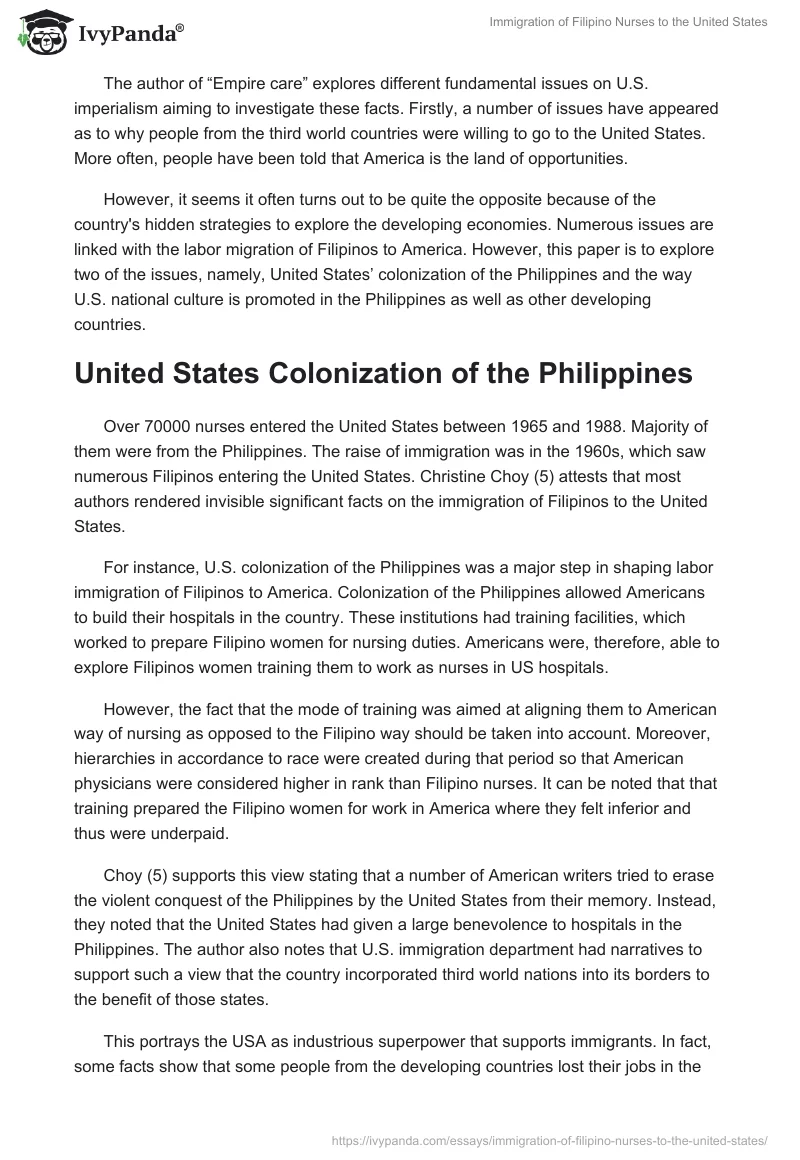Introduction
Cultural diversity in the United States was brought about by immigration. In fact, almost all the ethnic groups in the country are constructed of the immigrants. For instance, the white majority in the United States are descendants of migrants from Europe. Likewise, most minority ethnic groups have come from other parts of the world, namely, Africa, Asia, South and North Americas, among others.
In essence, understanding the relationship between ethnic groups in the United States requires an deep study of the history of U.S. immigration. However, it is important to note that the United States has always planned to institutionalize immigration. For instance, it introduced professional visas aimed at addressing labor shortages.
This was particularly widespread in nursing profession, in which the human resources were mainly sourced from Asian countries. This paper aims at the immigration of Filipino nurses to the United States. It is worth noting that United States’ immigration policy towards the Philippines was quite guarded. This paper studies immigration of Filipino nurses to the country.
Empire of care
The migration of Filipino nurses to the United States in the twentieth century has raised many concerns as to the cause of such a trend. When the process is looked in the context of U.S. imperialism, it raises more questions than answers.
For instance, why did the U.S. occupy the Philippines? Was it a planned action to provide the U.S. with cheap labor? Why did the U.S. set up their hospitals in the Philippines? Why were Filipinos trained in those medical centers? Actually, these issues focus on whether the U.S. planned to build “empire care” using Filipino nurses.
The author of “Empire care” explores different fundamental issues on U.S. imperialism aiming to investigate these facts. Firstly, a number of issues have appeared as to why people from the third world countries were willing to go to the United States. More often, people have been told that America is the land of opportunities.
However, it seems it often turns out to be quite the opposite because of the country’s hidden strategies to explore the developing economies. Numerous issues are linked with the labor migration of Filipinos to America. However, this paper is to explore two of the issues, namely, United States’ colonization of the Philippines and the way U.S. national culture is promoted in the Philippines as well as other developing countries.
United States Colonization of the Philippines
Over 70000 nurses entered the United States between 1965 and 1988. Majority of them were from the Philippines. The raise of immigration was in the 1960s, which saw numerous Filipinos entering the United States. Christine Choy (5) attests that most authors rendered invisible significant facts on the immigration of Filipinos to the United States.
For instance, U.S. colonization of the Philippines was a major step in shaping labor immigration of Filipinos to America. Colonization of the Philippines allowed Americans to build their hospitals in the country. These institutions had training facilities, which worked to prepare Filipino women for nursing duties. Americans were, therefore, able to explore Filipinos women training them to work as nurses in US hospitals.
However, the fact that the mode of training was aimed at aligning them to American way of nursing as opposed to the Filipino way should be taken into account. Moreover, hierarchies in accordance to race were created during that period so that American physicians were considered higher in rank than Filipino nurses. It can be noted that that training prepared the Filipino women for work in America where they felt inferior and thus were underpaid.
Choy (5) supports this view stating that a number of American writers tried to erase the violent conquest of the Philippines by the United States from their memory. Instead, they noted that the United States had given a large benevolence to hospitals in the Philippines. The author also notes that U.S. immigration department had narratives to support such a view that the country incorporated third world nations into its borders to the benefit of those states.
This portrays the USA as industrious superpower that supports immigrants. In fact, some facts show that some people from the developing countries lost their jobs in the process of helping foreigners. The author mentions persecution of Wen Lee, a nuclear physicist, as an illustration of anger and resentment from the American mainstream. In this regard, she refuses to acknowledge the fact that immigration of skilled workers is done to the advantage of immigrants.
Instead, she feels that these acts were possibly preplanned in order to exploit cheap labor from third world countries like the Philippines. Essentially, colonization of the Philippines aided the U.S. in instituting their culture on the Philippines. Moreover, Americanization of Filipino nursing facilities made it easier for Filipino nurses to learn American ways of nursing practices. Therefore, colonization of the Philippines was essential in shaping labor migration of Filipino nurses to the United States.
Promotion of U.S. National Culture in the Third World
The next factor that influenced Filipino nurses in the United States is the culture of the United States they were to adopt. Choy (112) asserts that the United States has agencies programmed to market its cultural trends to the third world nations. In the process, immigrants were promised citizenship, equality, as well as opportunities.
The author pays close attention to responses on these promises. She also focuses on the views of American nurses, Philippine government, American hospital employers and American government, among other sides involved. Form the information collected, Choy finds out that numerous debates arouse over the promises given by American health officials and government to Filipino nurses.
In this respect, she finds out that American agents marketed their country to third world nationals with empty promises. According to Choy (120), nursing in the United States is targeted at exploitation of cheap labor, while resulting in betrayal of trust.
The immigration to the U.S. is promoted by the propaganda that finds its way in the third world. This information is aired by U.S. media as well as local media. U.S. culture is thus seen as superior. In addition, America is seen as a land of opportunity. However, there are still issues surrounding inequality.
Moreover, the United States views its actions as advantageous to other nations. Nonetheless based on information from practicing Filipino nurses, this statement is untrue. For instance, Choy (186) notes that nurses from the Philippines were paid $ 5 per hour while their US counterparts were given $13 per hour.
This shows the disparity and inequality shown to immigrant nurses. In essence, the government of the U.S. has tried to monitor illegal migration of nurses from the Philippines (Choy 187). Attracted by the culture promoted, many Filipino nurses, instead of having gained new opportunities, lost their jobs and were forced to seek new work in the U.S. This has even caused illegal migrants to be taken to the U.S. by agencies with a view of exploiting them in order to reduce their expenses.
How the Two Issues Affect Each Other
Colonization of the Philippine was essential in involving Filipino women in nursing profession. However, this alone could not trigger immigration. Other factors, such as unemployment, desire for more pay, have also been attributed to this. However, it is necessary to note that the culture of the United States also played a big role in attracting Filipino workers to immigrate to the country. In this regard, it can be observed that after colonization, Philippine health sector was Americanized.
This was followed by propaganda on promises expected abroad. Nurses were, therefore, excited and enticed to try a new life in the United States. This way, promotion of US culture influenced migration of the country.
In essence, the two issues were intertwined as they helped in attracting nurses to move to the United States. These happenings raise credible questions on whether they were planned or not. Nonetheless, only US government can answer these questions. Although it should admit that Filipino workers have been of great help to the USA.
Conclusion
The book examines Filipino nurses’ experiences in the United States. In addition, it examines the motive behind their movement to the United States. The author also explores issues that led to the migration of nurses, issues surrounding inequality, denied citizenship, and false opportunities.
The author is suspicious of the true intentions of United States’ involvement in professional migrants. She wonders why the U.S. acted indifferently concerning migrant nurses. The author focuses mainly on Filipino nurses who, she claims, were mishandled in the United States. She even mentions Filipino war veterans forgotten by the United States. She reads mischief in United States’ actions in regard to immigration. She expects the U.S. to be more open on their immigration agenda.
Works Cited
Choy, Catherine. Empire of Care: Nursing and Migration in Filipino American History, Durham: Duke University Press, 2003. Print.

